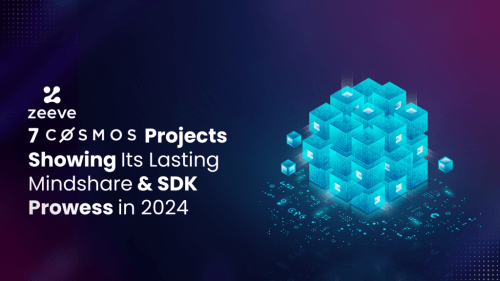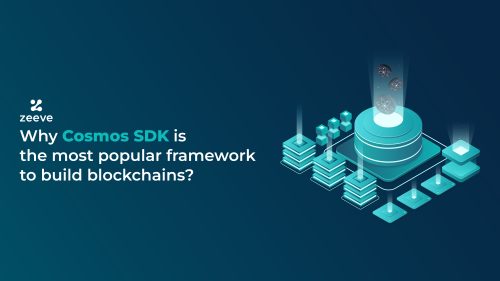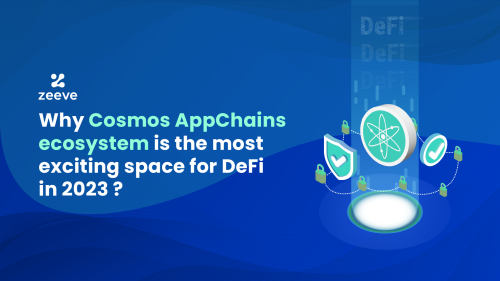7 Cosmos Projects Showing Its Lasting Mindshare & SDK Prowess in 2025

If you are one of those who think Cosmos is all about just a handful of projects from 2021 that dominated the Web3 horizon, like Osmosis, SEI, dYdX, and Gravity. In reality, you choose any of the hottest narratives, like Crypto x AI, DePIN, or RWA, and scan the top 20 projects in each category; what you will see is that at least 2-3 projects are from Cosmos itself. Cosmos is like the iceberg, showing a little and hiding the most. We believe 2025 is going to be the year that has hidden a lot awaiting to be unveiled.
So, if folks have been thinking that after the Terra Luna catastrophe, Cosmos SDK’s dust has settled, they are wrong. At the time of writing, Cosmos secured 4th rank as the most successful blockchain based on developer activity. It is expected that, like 2021 and beyond, 2025 will also carry the momentum forward for Cosmos, with top Cosmos projects for 2025 choosing it as its native ecosystem.
Let’s look at a few top projects of 2024 that have significant mindshare in Crypto Twitter, what they are building, and how they use Cosmos SDK as a part of their development stack.

Top Big Projects & Their Intention To Choose Cosmos SDK as Their Development Platform
1. Nillion
Nillion, a blind computation project on Cosmos, is waiting for it’s TGE, and the reason they are going big is because AI is on the rise, and data is the oil for AI to operate efficiently. However, corporations, on the pretext of using the data to better customer experience through AI are abusing it for their own vested interests. Cambridge Analytica is a subtle example of the abuse in the hands of corporations to influence outcomes.
So, when you know that AI will be an integral part of the population in the future, it should be made safe and secure for use.
To ensure that privacy is the only way forward where corporations can tap the data and not make users vulnerable to hacks and exploits. That’s where Nillion’s blind computation makes the difference by helping corporations scale big. So, they can even bypass the challenges posed by the GDPR rules and still perform well to serve customers.
Since Nilchain is the coordination layer or the connecting bridge for the Nillion ecosystem with other ecosystems for performing the blind data computation, it should be universally compatible with all other ecosystems. For that matter, Nillion is using the Cosmos SDK, which allows better interconnectivity to occur with other chains without compromising the speed and the sovereignty of the ecosystem.
Hence, Nillion can easily manage liquidity, interoperability, transparency, and security while interacting with different ecosystems using the Cosmos SDK IBC and Interchain security working as a top cosmos project for 2025.
So far, Nillion has raised $50 M from investors through Hack VC, Hashkey Capital, Big Brain, GSR, Balaji Srinivasan, Arthur Hayes, and other Tier1 investors. Andrew Jonathan Masanto, the CEO of Nillion, says,
“It is imperative that data has the upgraded rails to handle the growing needs of secure storage and computation in this brave new world.” In this pursuit, Cosmos SDK amalgamation with Nillion drives a positive road ahead.
2. Babylonchain
Babylon: the EigenLayer of BTC. It has bridged two separate islands together, ETH and BTC, to collectively bring $1.2 T to secure a complete network and reward the users for the same.
But when connecting two islands to move things back and forth, the bridge must be strong enough to sustain the movement. Similarly, when BTC is being used to secure a whole new PoS network, the BTC validators must be safe from exploits at the hands of scammers.
That’s where Cosmos SDK has provided a trade-off to the Babylon Chain. Any instances of false signing to scam BTC validators can be mitigated through the Cosmos SDK due to its interoperability capabilities through IBC/interchain security.. This means Babylonchains can easily inherit the native time stamping feature of the Cosmos SDK, which watches all other chain activity like a third eye/watch tower.
Moreover, Cosmos SDK also lets Babylonchain access other partner integrations of the Cosmos Hub, like the Axelar Network. Axelar opens the gates of Babylonchain beyond Cosmos because it is interoperable with all other chains other than Cosmos.
So, BTC validators can also time-stamp these chains and get economic benefits from them. These benefits are simply alluring when you are launching as a top project On the Cosmos chain in 2025.
And it wouldn’t be surprising when you have a 100+ chain integrated system as your base for building your network raise funding from investors. As a result , Babylon has already been integrated with more than 16 appchains with a market cap of $1.4 billion and raised $70M in funding from Paradigm, Binance, polychain Capital, and IDG Capital.
And if you feel that $1.4 B for Babylonchain is very small, let us help you interpret it. With 1.4B, it surpassed the current market cap of a Web3 stalwart like Polygon on Nov 14, valued at $1.05 billion. With more than 300K users in its testnet and integration with 16 PoS dapps, Babylon Chain ain’t a baby anymore since the potential is huge with the passing time.
3. Saga
Saga is doing the same for Web3 that AWS did for Web2, simplifying adoption. But one would say that in the presence of Cosmos SDK, why’d we even need Saga to expedite development? With Cosmos, there’s an innate problem of gathering validators, distributing staking tokens, and designing a token mechanism, taking months to undertake development.
Saga abstracts all of that through a shared security called Chainlets. Thereby allowing the launching of a bespoke L1 with an L1 stack to occur with expediency. So, launching a new blockchain within a week becomes easy.
Sounds like the Cosmos in a new veil. But that’s not it; it is indeed Cosmos because the Chainlets will use the Cosmos IBC bridge to inherit the security of the Saga mainnet.
Moreover, all these applications can further access a wide range of Cosmos SDK modules, along with different virtual machines like EVM, Cosmwasm, SolanaVM, and MoveV. All of these would give the flexibility to choose different implementation models like Juno’s Cosmwasm or Osmosis’s version.
So far, the Saga blockchain has raised cumulative funding of $13 million from top investors like Maven 11, Polygon Studios, Samsung NEXT, Chorus One, Akash Network, and more and emerged as one of the top Cosmos Projects for 2025 to keep on your radar.
4. UnionBuild
UnionBuild is emerging as the top project to keep on your radar for 2025 because it introduces modularity that goes hand-in-hand with composability. Because, so far, asynchronous composability is a far-fetched dream in a traditional L1 environment. However, UnionBuild is all set to change that from the ground up using a ZK-proving system to connect with different chains. However, there’s one problem that Union Build has faced nonetheless.
The problem of delayed proving using the Zk-Proving system. This means, typically, it can take more than 6 minutes to provide a cross-chain transaction without relying on intermediary bridging protocols, which are vulnerable to hacks. But Cosmos SDK’s introduction in the picture has completely scripted possibilities. By abstracting the CometBFT with CometBLS, which Cosmos SDK grants, UnionBuild is now not just making proving cheaper but also very fast to uplift the user experience.
Union Build has raised $4 million in seed funding to build bridges connecting different Layer 1 and Layer 2 networks with ZK proofs from Galileo, Semantic Ventures, Tioga Capital, Nascent, Lightshift, and Chorus One.
On Thursday, June 27th this year, the Union Testnet went live with 2.132.680 packets and fulfilled 1.760.386 transfers. In the next few months, UnionBuild is committed to launching new networks, faster proving times, and support for L2s and L3s to eliminate the barriers between isolated blockchains.
5. Talus
Talus Network spearheads a change in the Crypto x AI sector by allowing blockchains to integrate with AI. But why is it even necessary? To understand this, you need to realize that AI relies on data to train its models. However, if the training data is centralized or filtered via a single source, it can be misused by a great proportion by crony corporations. Talus amalgamates blockchain with AI using MOVE programming to allow smart contracts to work with AI systems and restrict this possibility.
But when you are training a complete AI model democratically, you need interoperability, cross-chain atomicity, and scalability without compromising modularity.
In this regard, Talus has been aided by the Cosmos SDK due to its high-performance components, which allow Talus to abstract the possibility of developing from scratch. So, Talus, through Cosmos’ wider ecosystem, can access other protocols like SUI to build a high-performance system. Hence, if you want to know why Cosmos SDK is the gold standard for custom blockchain, these are a few reasons and top cosmos projects dominating 2025 like 2021, will not be a surprise sight anymore.
So far, Talus has raised $3M in funding from Polychain, Dao5, WAGMI Ventures, and a few more front-row investors. In addition, Nvidia, IBM, Blue7, Symbolic Capital, and Render Network will help Talus to make the democratization of AI on-chain possible, ensuring that users are in the driving seat.
In support of this vision, Ben Frigon, COO of Talus Network, emphasized,
“Our mission is to foster consumer-friendly AI applications, particularly smart agents, that seamlessly integrate into everyday on-chain life. More importantly, we’re on the way to democratize AI, ensuring that it’s the users who hold the reins of control”.
6. AIOZ
Here comes a DePIN L1.
With the rise in the demand for online consumption, relying on a centralized entity to safeguard your data could pose a significant threat to your data as an enterprise in the following way.
To avoid losing millions of dollars due to data unavailability for customers, AIOZ has introduced a new paradigm where you can overcome the erstwhile challenges in data processing, monopolization of the data storage, and privacy through decentralized streaming through 180k+ AIOZ DePIN nodes. However, when you are either storing the data for training models or business use, data privacy is paramount.
AIOZ is using IPFS systems that will be powered by the robustness of the Cosmos SDK and the compatibility of the EVM. So, any application developed using the AIOZ platform can access a broader COSMOS and EVM ecosystem. Hence, it allows seamless value transfer across a wider Web 3 ecosystem. In addition to this, since AIOZ supports both web assembly and solidity, developers can create and deploy multiple applications.
At the time of writing, AIOZ has more than 190,000+ global edge nodes that contribute to its processing power. AIOZ as the top Cosmos Projects for 2025 has great potential to completely take the DePin market by storm.
7. Allora
What if the training data available to AI can be centralized for benefitting a specific cohort only? That’s what the existing training models unfold when they are in the hands of a few big corporations with tons of data available for training. But Allora chain is abstracting the same by introducing transparency dynamism in data sharing. So, in this transparent, open marketplace powered by Allora, anyone can participate as a contributor to data to train the AI models and earn money in the process. But this process would demand scalability when done in a decentralized manner and requires an optimized fee structure. This means you need to redo the consensus from the ground up.
But, such an approach is non-feasible when the network expands every moment.
That’s where Cosmos SDK is helping Allora scale as per the network demand. Allora is using the Cosmos SDK to create module accounts, which will allow gas optimization as per the request. Hence, it will be possible to make transactions either gasless or with minimum gas as per the request to scale the ecosystem.
Therefore, if it is a small query, there’s a different gas limit. Likewise, if that query is accepted, the gas limits will either increase or decrease based on the network activity. Cosmos SDK’s tendermint core allows such efficacies to happen on-chain.
So far, Allora has raised close to 35M to build the network.
As of November 6. 2024, here is a bit of traction they got:
- 120,000+ nodes contribute to Allora’s decentralized AI network.
- Enhanced reward distribution management.
- Improved initial regrets tracking for fast-iteration topics.
- Elevated merit-based sortitioning.
These are a few top Cosmos SDK projects of 2025 which have used Cosmos SDK in the best manner possible to overcome their technical battle. If you are planning to build using the Cosmos SDK, you need a trusted partner in the market to help you launch your application.
Build Your Own Cosmos SDK Chain With Zeeve
Zeeve has been spearheading to fulfill the demand for custom blockchain using the Cosmos SDK chains with additional dev tools and plugins. If you are planning to deploy your modular Cosmos SDK chain, in that case, our team can help in enabling seamless interoperability integrating with IBC, get Block explorers, faucets, data indexing tools, and more, along with scalable nodes and APIs for your Cosmos Chains. Moreover, Zeeve also aids in launching your custom L1 blockchain quickly, either from scratch or migrating from an existing blockchain network, with minimal turnaround time and without any risk of data loss. Launching as a Cosmos SDK project in 2025 comes with a lot of trade off, so if you want to explore possibilities, read more about Zeeve’s appchain infrastructure-as-a-service for Cosmos SDK. If you want to get more info, you can schedule a call and get in touch with our Web3 experts. They will be helping you choose the right stack for your next project.





Responses